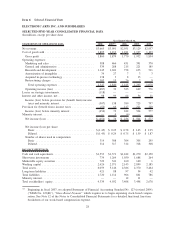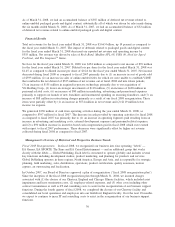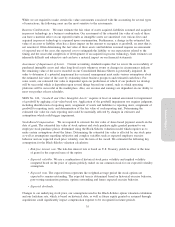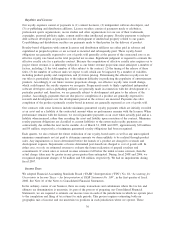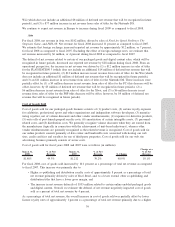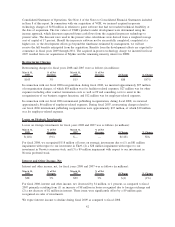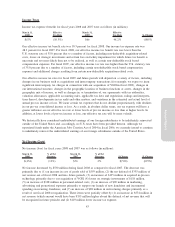Electronic Arts 2008 Annual Report Download - page 111
Download and view the complete annual report
Please find page 111 of the 2008 Electronic Arts annual report below. You can navigate through the pages in the report by either clicking on the pages listed below, or by using the keyword search tool below to find specific information within the annual report.
While we are required to make certain fair value assessments associated with the accounting for several types
of transactions, the following areas are the most sensitive to the assessments:
Business Combinations. We must estimate the fair value of assets acquired, liabilities assumed and acquired
in-process technology in a business combination. Our assessment of the estimated fair value of each of these
can have a material affect on our reported results as intangible assets are amortized over various lives and
acquired in-process technology is expensed upon consummation. Furthermore, a change in the estimated fair
value of an asset or liability often has a direct impact on the amount to recognize as goodwill, an asset that is
not amortized. Often determining the fair value of these assets and liabilities assumed requires an assessment
of expected use of the asset, the expected cost to extinguish the liability or our expectations related to the
timing and the successful completion of development of an acquired in-process technology. Such estimates are
inherently difficult and subjective and can have a material impact on our financial statements.
Assessment of Impairment of Assets. Current accounting standards require that we assess the recoverability of
purchased intangible assets and other long-lived assets whenever events or changes in circumstances indicate
the remaining value of the assets recorded on our Consolidated Balance Sheets is potentially impaired. In
order to determine if a potential impairment has occurred, management must make various assumptions about
the estimated fair value of the asset by evaluating future business prospects and estimated cash flows. For
some assets, our estimated fair value is dependent upon our predictions of which of our products we develop
will be successful which is dependent upon several things beyond our control, such as which operating
platforms will be successful in the marketplace. Also, our revenue and earnings are dependent on our ability to
meet our product release schedules.
SFAS No. 142, “Goodwill and Other Intangible Assets” requires at least an annual assessment for impairment
of goodwill by applying a fair-value-based test. Application of the goodwill impairment test requires judgment,
including identification of reporting units, assignment of assets and liabilities to reporting units, assignment of
goodwill to reporting units, and determination of the fair value of each reporting unit. Determining the
estimated fair value for each reporting unit could be materially affected by changes in estimates and
assumptions which could trigger impairment.
Stock-Based Compensation. We are required to estimate the fair value of share-based payment awards on the
date of grant. The estimated fair value of stock options and stock purchase rights granted pursuant to our
employee stock purchase plan is determined using the Black-Scholes valuation model which requires us to
make certain assumptions about the future. Determining the estimated fair value is affected by our stock price
as well as assumptions regarding subjective and complex variables such as expected employee exercise
behavior and our expected stock price volatility over the term of the award. We estimated the following key
assumptions for the Black-Scholes valuation calculation:
•Risk-free interest rate. The risk-free interest rate is based on U.S. Treasury yields in effect at the time
of grant for the expected term of the option.
•Expected volatility. We use a combination of historical stock price volatility and implied volatility
computed based on the price of options publicly traded on our common stock for our expected volatility
assumption.
•Expected term. The expected term represents the weighted-average period the stock options are
expected to remain outstanding. The expected term is determined based on historical exercise behavior,
post-vesting termination patterns, options outstanding and future expected exercise behavior.
•Expected dividends.
Changes to our underlying stock price, our assumptions used in the Black-Scholes option valuation calculation
and our forfeiture rate, which is based on historical data, as well as future equity granted or assumed through
acquisitions could significantly impact compensation expense to be recognized in future periods.
Annual Report
35





